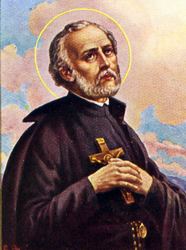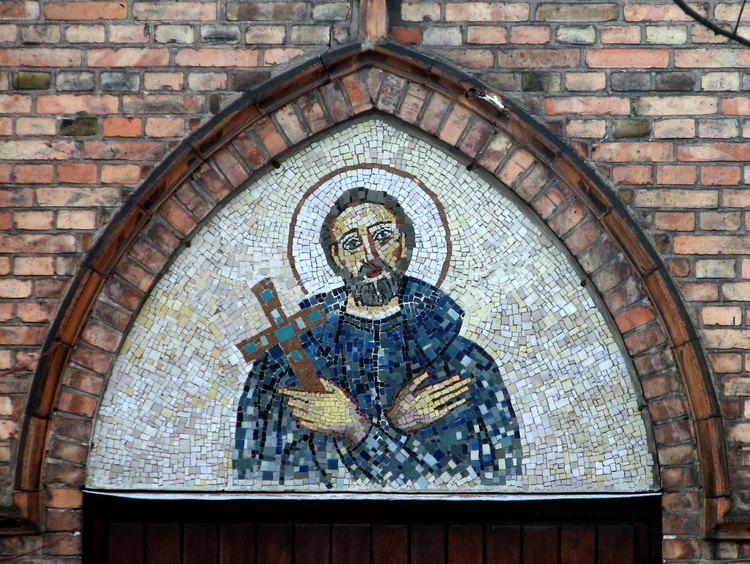Feast 16 May Name Andrew Bobola | Role Martyr Parents Mikolaj Bobola | |
 | ||
Venerated in Roman Catholicism (by Poland and the Society of Jesus) | ||
St andrew bobola
Saint Andrew Bobola, S.J. (Polish: Andrzej Bobola, 1591 – 16 May 1657) was a Polish missionary and martyr of the Society of Jesus, known as the Apostle of Lithuania and the "hunter of souls".
Contents
- St andrew bobola
- Living in Faith Daily Prayer May the life of Andrew Bobola inspire missionaries
- Life
- Veneration
- References

Living in Faith: Daily Prayer – May the life of Andrew Bobola inspire missionaries
Life

Bobola was born in 1591 into a noble family in the Sandomir Palatinate in the Province of Lesser Poland of the Crown of the Kingdom of Poland, then a constituent part of the Polish–Lithuanian Commonwealth. In 1611 he entered the Society of Jesus in Vilnius, then in the Grand Duchy of Lithuania, the other part of the Commonwealth. He subsequently professed solemn vows and was ordained in 1622, after which he served for several years as an advisor, preacher, Superior of a Jesuit residence, etc., in various places.

From 1652 Bobola also worked as a country "missionary", in various locations of Lithuania: these included Polotsk, where he was probably stationed in 1655, and also Pinsk, (both now in Belarus). On 16 May 1657, during the Khmelnytsky Uprising, he was captured in the village of Janów (now Ivanava, Belarus) by the Cossacks of Bohdan Chmielnicki and, after being subjected to a variety of tortures, killed.

One description of Bobola's death written in 1865 states:
In the same year, the Cossacks surprised a holy Polish Jesuit, in the town of Pinsk, and conferred on him the palm of martyrdom, on the 16th of May, 1657. Father Andrew Bobola, ...had just offered up the holy sacrifice, when a horde of Cossacks attacked the town. On beholding the barbarians, Father Bobola fell upon his knees, raised his eyes and his hands toward heaven, and, having a presentiment that his hour had arrived, exclaimed, "Lord, thy will be done!" At that moment, the Cossacks rushed upon him, stripped him of his holy habit, tied him to a tree, placed a crown upon his head, ...after which they scourged him, tore out one of his eyes, burned his body with torches, and one of the ruffians traced, with his poignard, the form of a tonsure on the head of the venerable Father, and on his back the figure of a chasuble! To do this, the executioner had to strip off the skin of the holy martyr! But this was not yet all. The fingers of the apostle had received the priestly unction. The executioner tore from them the skin, and forced needles under his nails! And during this indescribable torture, the hero prayed for his tormentors; he preached, both by word and example, until the schismatics tore out his tongue and crushed his head. Father Andrew Bobola, whom the Church declared Blessed, the 30th of October, 1853, was sixty-five years of age.
A second account states that when Bobola refused to renounce his religion, he was stripped, tied to a hedge and whipped. In mockery, the Cossacks placed a crown of twigs on his head and then dragged him to his place of execution, a butcher's shop.
Veneration
Bobola's body was originally buried in the Jesuit church in Pinsk. It was later moved to their church in Polotsk. By the beginning of the 18th century, however, nobody knew where Bobola's body was buried. In 1701 Father Martin Godebski, S.J., the Rector of the Pinsk College, reputedly had a vision of Bobola. This caused him to order a search for the body. It was reportedly found completely incorrupt, which was recognized by the Church and its supporters as proof of holiness. In 1719 the casket was officially reopened and the body inspected by qualified medical personnel (five physicians and pharmacists). It was reportedly still completely incorrupt: pliable and with soft flesh.
In 1922, the Bolsheviks moved the corpse, later described by an American journalist as a "remarkably well-preserved mummy", to the Museum of Hygiene of People's Commissioners of Health in Moscow. The whereabouts of the remains was not known to the Catholic authorities, and Pope Pius XI charged the Papal Famine Relief Mission in Russia, headed by American Jesuit Father Edmund A. Walsh, with the task of locating and "rescuing" them. In October 1923—as a kind of "pay" for help during famine—the remains were released to Walsh and his Assistant Director, Father Louis J. Gallagher, S.J. Well packed by the two Jesuits, they were delivered to the Holy See by Gallagher on All Saints' Day (1 November) 1923. In May 1924, the relics were installed in Rome's Church of the Gesù, the main church of the Society of Jesus.
Since 17 June 1938 the body has been venerated at a shrine in Warsaw, with an arm remaining at the original shrine in Rome.
Declared Blessed by Pope Pius IX on 30 October 1853, Bobola was canonized by Pope Pius XI on 17 April 1938. His feast day was originally celebrated by the Jesuits on 23 May, but it is now generally celebrated on 16 May. On his feast day in 2002, Pope John Paul II declared Bobola a patron saint of Poland and of the Roman Catholic Archdiocese of Warsaw.
Today some join Bobola with St. Peter the Aleut, an alleged martyr for the Eastern Orthodox Church at the hands of Catholics, in a special devotion for the reunion of the two branches of Christianity. However, the historicity of the martyrdom of Peter the Aleut is not clearly established.
